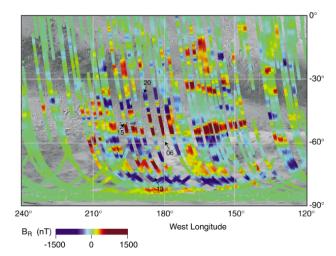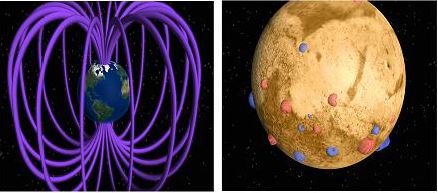
|
Magnetic Strips Preserve Record of Ancient Mars
- Click the image above for a larger view
- Full-Res JPEG (1152 x 879) (147.9 kB)
- Full-Res TIFF (1152 x 879) (1.4 MB)
Caption:
This image is a map of Martian magnetic fields in the southern highlands near the Terra Cimmeria and Terra Sirenum regions, centered around 180 degrees longitude from the equator to the pole. It is where magnetic stripes possibly resulting from crustal movement are most prominent. The bands are oriented approximately east - west and are about 100 miles wide and 600 miles long, although the longest band stretches more than 1200 miles. The false blue and red colors represent invisible magnetic fields in the Martian crust that point in opposite directions. The magnetic fields appear to be organized in bands, with adjacent bands pointing in opposite directions, giving these stripes a striking similarity to patterns seen in the Earth's crust at the mid-oceanic ridges.
NASA's Mars Global Surveyor has discovered surprising new evidence of past movement of the Martian crust, suggesting that ancient Mars was a more dynamic, Earth-like planet than it is today.
Scientists using the spacecraft's magnetometer have found banded patterns of magnetic fields on the Martian surface. The adjacent magnetic bands point in opposite directions, giving these invisible stripes a striking similarity to patterns seen in the crust of Earth's sea floors.
Above: An artist's concept comparing the present day magnetic fields on Earth and Mars. Earth's magnetic field is generated by an active dynamo - a hot core of molten metal. The magnetic field surrounds Earth and is considered global (left). The various Martian magnetic fields (right) do not encompass the entire planet and are local. The Martian dynamo is extinct, and its magnetic fields are 'fossil' remnants of its ancient, global magnetic field. I
On the Earth, the sea floor spreads apart slowly at mid-oceanic ridges as new crust flows up from Earth's hot interior. Meanwhile, the direction of Earth's magnetic field reverses occasionally, resulting in alternating stripes in the new crust that carry a fossil record of the past hundreds of million years of Earth's magnetic history, a finding that validated the once-controversial theory of plate tectonics.
"The discovery of this pattern on Mars could revolutionize current thinking of the red planet's evolution," said Dr. Jack Connerney of NASA's Goddard Space Flight Center, Greenbelt, MD, an investigator on the Global Surveyor's magnetometer team. "If the bands on Mars are an imprint of crustal spreading, they are a relic of an early era of plate tectonics on Mars. However, unlike on Earth, the implied plate tectonic activity on Mars is most likely extinct."
Alternate explanations for the banded structure may involve the fracturing and breakup of an ancient, uniformly magnetized crust due to volcanic activity or tectonic stresses from the rise and fall of neighboring terrain.
"Imagine a thin coat of dried paint on a balloon, where the paint is the crust of Mars," explained Dr. Mario Acuna of Goddard, principal investigator on the Global Surveyor magnetometer. "If we inflate the balloon further, cracks can develop in the paint, and the edges of the cracks will automatically have opposite polarities, because nature does not allow there to be a positive pole without a negative counterpart."
Peer-reviewed research based on the observations will be published in the April 30 issue of the journal Science.
The observations of the so-called magnetic stripes were made possible because of Mars Global Surveyor's special aerobraking orbit. This process of dipping into the upper atmosphere of Mars to gradually shape the probe's orbit into a circle was extended due to a problem with a solar panel on the spacecraft. The lowest point of each elliptically shaped orbit curved below the planet's ionosphere, allowing the magnetometer to obtain better-than-planned regional measurements of Mars.
"At its nominal orbit more than 200 miles high, the instruments face too much magnetic interference, and they do not have the resolution to detect these features," Acuna noted. "We began with misfortune, and ended up winning the lottery."
The bands of magnetized crust apparently formed in the distant past when Mars had an active dynamo, or hot core of molten metal, which generated a global magnetic field. Mars was geologically active, with molten rock rising from below cooling at the surface and forming new crust. As the new crust solidified, the magnetic field that permeated the rock was "frozen" in the crust. Periodically, conditions in the dynamo changed and the global magnetic field reversed direction. The oppositely directed magnetic field was then frozen into newer crust.
Above: These images are an artist's concept of the process that may have generated magnetic stripes in the crust of ancient Mars. In the left image, the blue arrows and compass needle indicate the direction of the magnetic field. The yellow-orange shape represents a pool of molten rock (magma)upwelling beneath the Martian crust. The red and blue bands are magnetized crust on either side of a spreading center, or rift.
"Like a Martian tape recorder, the crust has preserved a fossil record of the magnetic field directions that prevailed at different times in the ancient past," Connerney said. When the planet's hot core cooled, the dynamo ceased and the global magnetic field of Mars vanished. However, a record of the magnetic field was preserved in the crust and detected by the Global Surveyor instrument.
The mission's map of Martian magnetic regions may help solve another mystery -- the origin of a striking difference in appearance between the smooth, sparsely cratered northern lowlands of Mars and the heavily cratered southern highlands. The map reveals that the northern regions are largely free of magnetism, indicating the northern crust formed after the dynamo died. "The dynamo likely died a few hundred million years after Mars' formation. One possibility is that later asteroid impacts followed by volcanic activity heated and shocked large areas of the northern crust, obliterating any local magnetic fields and smoothing the terrain," Acuna said. "When the crust cooled, there was no longer a global magnetic field to become frozen in again."
The map also identifies an area in the southern highlands as the oldest surviving unmodified crust on Mars. This area on Marsis where the magnetic stripes are most prominent. The bands are oriented approximately east-to-west and are about 100 miles wide and 600 miles long, although the longest band stretches more than 1,200 miles.
"The bands are wider than those on Earth, perhaps for a couple of reasons," Connerney said. "The Martian crust could have been generated at a greater rate, causing a given magnetic field to be imprinted over a wider area before it reversed direction. Second, the Martian magnetic field may have reversed direction less frequently, which would have given more time for anyone field direction to imprint itself in the steadily moving crust, resulting in wider bands.
In order to call this pattern a crustal spreading center like that observed in the mid-oceanic ridges on Earth, we need to find a point of symmetry, where the pattern on one side matches the pattern on the other. We have not yet found evidence of this type of symmetry," Connerney added.
Cataloging Keywords:
| Name | Value | Additional Values |
|---|---|---|
| Target | Mars | |
| System | ||
| Target Type | Planet | |
| Mission | Mars Global Surveyor (MGS) | |
| Instrument Host | Mars Global Surveyor | |
| Host Type | Orbiter | |
| Instrument | Magnetometer | |
| Detector | ||
| Extra Keywords | Artwork, Asteroid, Atmosphere, Color, Crater, Impact, Magnetosphere, Map, Volcano | |
| Acquisition Date | ||
| Release Date | 1999-05-03 | |
| Date in Caption | ||
| Image Credit | NASA, Jack Connerney, Mario Acuna, Carol Ladd | |
| Source | photojournal.jpl.nasa.gov/catalog/PIA02008 | |
| Identifier | PIA02008 | |


